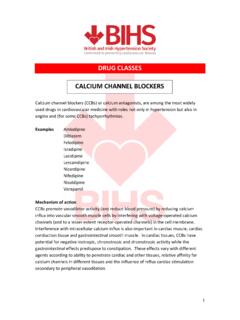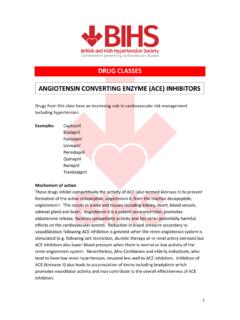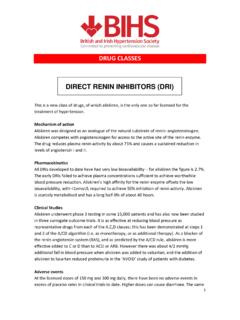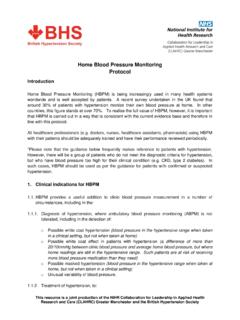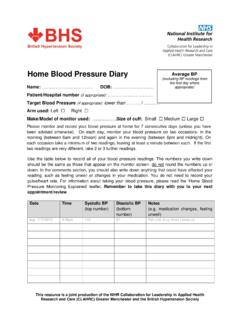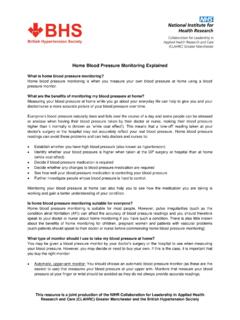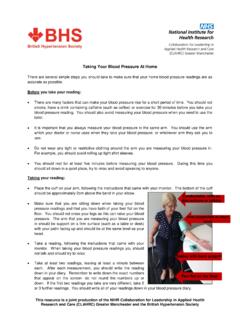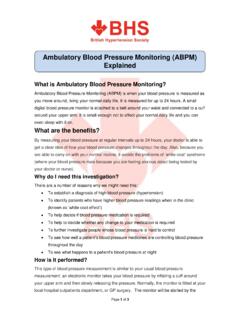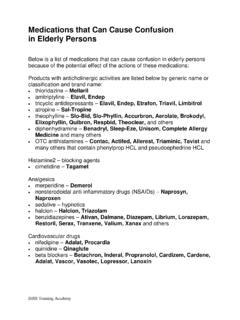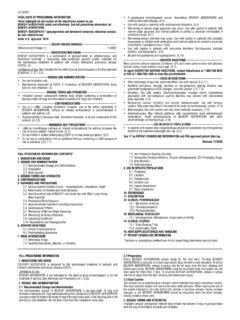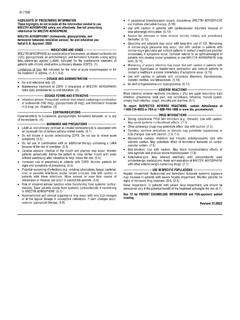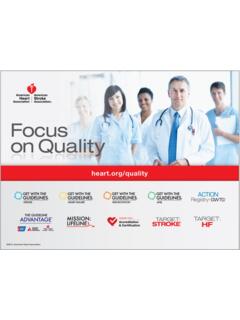Transcription of BETA-ADRENOCEPTOR ANTAGONISTS (BETA-BLOCKERS)
1 1 DRUG CLASSES Beta- blockers have been widely used in the management of angina, certain tachyarrhythmias and heart failure, as well as in hypertension. Examples Acebutolol Atenolol Bisoprolol Carvedilol Celiprolol Labetalol Metoprolol Nadolol Nebivolol Oxprenolol Pindolol Sotalol Timolol Mechanism of action Beta- blockers antagonise the effects of sympathetic nerve stimulation or circulating catecholamines at beta-adrenoceptors which are widely distributed throughout body systems.
2 Beta1-receptors are predominant in the heart (and kidney) while beta2-receptors are predominant in other organs such as the lung, peripheral blood vessels and skeletal muscle. Heart : Blockade of beta1-receptors in the sino-atrial node reduces heart rate (negative chronotropic effect) and blockade of beta1-receptors in the myocardium decrease cardiac contractility (negative inotropic effect). BETA-ADRENOCEPTOR ANTAGONISTS (BETA- blockers ) 2 Kidney : Blockade of beta1-receptors inhibit the release of renin from juxta-glomerular cells and thereby reduce the activity of the renin-angiotensin-aldosterone system.
3 Central and peripheral nervous system : Blockade of beta-receptors in the brainstem and of prejunctional beta-receptors in the periphery inhibits the release of neurotransmitters and decreases sympathetic nervous system activity. The mode of action in lowering blood pressure remains controversial. Conventionally, the antihypertensive action of beta- blockers is attributed to cardiac effects (decreased heart rate and cardiac output). However, long-term reductions in blood pressure appear greater in individuals with high renin forms of hypertension, suggesting that renal actions are important.
4 Many beta- blockers have ancillary properties which may determine utility in hypertensive individuals. Selectivity : Since the desired effects of beta- blockers are mediated by blockade of beta1-receptors which predominate on the heart, cardioselective agents with relative selectivity for this receptor are generally preferred. However, cardioselectivity is not absolute and is lost at high doses. Examples of cardioselective beta- blockers include atenolol, bisoprolol and metoprolol. Partial agonist activity (intrinsic sympathomimetic activity) : This manifests as a beta-stimulant effect when background adrenergic activity is low ( during sleep) but beta-blockade occurs when adrenergic activity is increased ( during exercise).
5 Beta- blockers with partial agonist activity include pindolol. Membrane-stabilising activity : This confers a local anaesthetic and anti-arrhythmic effect sotalol. Other properties : Some beta- blockers also block effects mediated at peripheral alpha-adrenoceptors ( carvedilol and labetalol), stimulate beta2-adrenoceptors ( celiprolol) or have direct vasodilator activity ( nebivolol). Pharmacokinetics Beta- blockers vary in the degree of elimination by the kidney or the liver, usually with extensive first-pass metabolism.
6 Lipid-soluble beta- blockers , labetalol, metoprolol, pindolol and propranolol, typically depend upon hepatic metabolism for clearance, whereas water soluble beta- blockers atenolol are cleared by the kidney. Drugs eliminated by the liver tend to exhibit wide inter-individual variability in bioavailability. The half-life of most beta- blockers is relatively short; those eliminated by the kidney tend to have longer half-life. 3 Adverse effects Most are predictable Bronchospasm in susceptible individuals due to blockade of beta2-receptors which mediate dilation in the bronchi.
7 Asthma is an absolute contraindication for all beta- blockers . Bradycardia and impairment of myocardial contractility. Common but seldom symptomatic. Peripheral vasoconstriction due to blockade of beta2-receptors which subserve vasodilatation in blood vessels supplying skeletal muscle beds typically resulting in cold hands and feet, and possibly exacerbation of Raynaud s phenomenon. CNS effects due to reduced sympathetic outflow malaise; vivid dreams, nightmares and, rarely, hallucinations with highly lipid soluble beta- blockers which have greater penetration into the CNS.
8 Tiredness and fatigue due to blockade of beta2-receptors in skeletal muscle associated with increased muscle activity. Masking of hypoglycaemia in insulin-dependent diabetes because of blunting of sympathetic nervous activation. Hyperglycaemia Risk of new onset diabetes Practical issues All beta- blockers , irrespective of ancillary properties, lower blood pressure to a similar extent. Beta- blockers which undergo hepatic metabolism require a wide range of doses and usually multiple daily dosing. Drugs eliminated via the kidney may be suitable for once daily administration, particularly at high doses.
9 Beta1-selective (cardioselective) beta- blockers which can be administered once daily tend to be preferred atenolol 25 100 mg daily, bisoprolol 10 mg daily. Blood pressure reductions appear to be less marked in those with low renin hypertension such as the elderly and people of Afro-Caribbean descent. Beta- blockers combine well with thiazide and thiazide-like diuretics, and with dihydropyridine type calcium channel blockers to produce overall antihypertensive effects which are at least additive. However, beta- blockers should not normally be used in combination with rate-limiting calcium channel blockers (diltiazem and verapamil) because of the risk of heart block and potentially fatal bradyarrythmias.
10 Irrespective of apparent cardioselectivity , beta- blockers are contraindicated in people with asthma. All beta- blockers should be used with caution in chronic obstructive pulmonary disease with significant reversibility. In patients with less severe pulmonary disease, beta- blockers can be used without concern. Rarely, excessive reductions in inotropic activity may precipitate or exacerbate cardiac failure in susceptible individuals. While these depressant effects on cardiac function are occasionally deleterious, 4 reduction in cardiac work and reduction in myocardial oxygen demand contribute to the antianginal effects of these agents.
